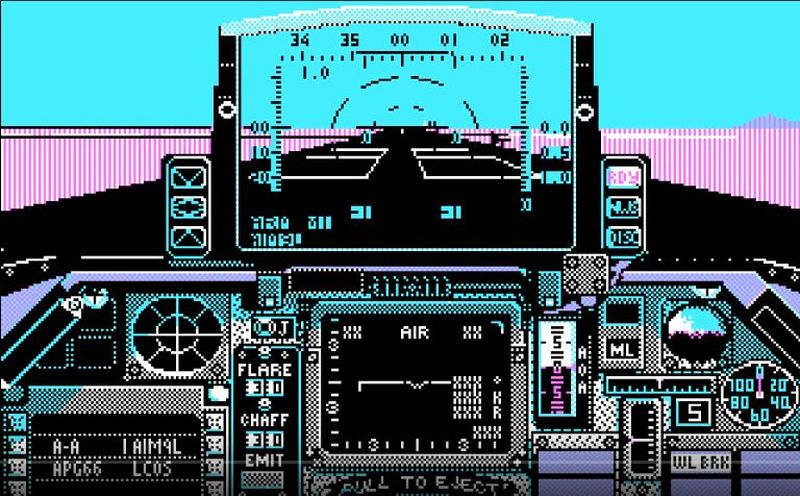
To Fly, perchance to Dream.
Join me on a humorous reminiscence of some of the high points in 20 Years of flight simming!
To fly, perchance to dream.
The dream of flight seems fundamental to the human condition.
From the legend of Icarus to the notion of astral projection it seems to be present in all cultures.
On a personal level, surely most of us have had "flying dream" where, escaping the clutches of gravity we seem to be able to float away from our wordly cares.
However in years of civilisation it is only in the past (not quite) 100 years that sustained, powered flight has become a reality. And it is only in the past 20 years that the masses have been able to spread their wings in virtual flight.
One of the best selling programs for the Apple II computer and Tandy TRS-80 personal computers in the early 1980's was Flight Simulator 1 by Sublogic. The primitive wire frame graphics moved oh, so slowly, but it did include "British Ace 3D Aerial Battle".
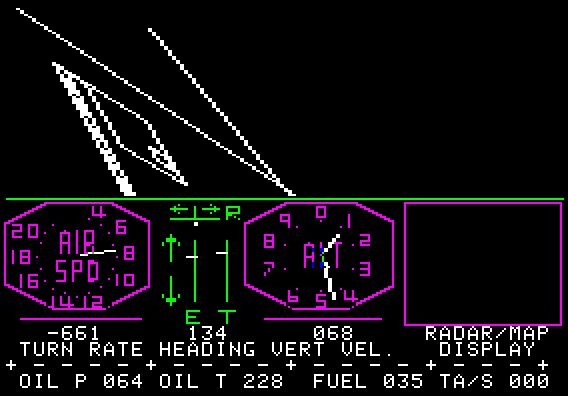
Flight Simulator 1. Primitive yes - but an exciting beginning nonetheless.
In the early 1980's I used to sit around with friends trying picture how far this technology could go.
"Wouldn't it be great if you could actually see trees... and .. how about... power lines! Power lines you could fly under. And what about real terrain, with hills, coastlines, rivers."
Ah, how our little minds boggled.
However I had learned enough about computers to know that it wasn't likely to happen in my lifetime. The math was simple.
For a start, to draw dots on a screen took processing power. The more dots, the slower the animation ran. Add colour and the display slowed again. The Apple could display a whopping 16 colours... but not all at the same time, and not any colour in any position.
The colour displayed at one positon depended on the colout being shown on each adjacent pixel.
A complicated and slow process.
The upshot was that I could never imagine enough pixels and colours being displayed to show anthing that looked vaguely "realistic". I mean, even multi million dollar military simulators looked, by and large, pretty dire.
The early personal computers just weren't designed to move graphics around the screen. It wasn't until the "games machines" came along from Commodore and Atari and they bundled a 16 bit processor with dedicated graphics hardware that flying got interesting looking enough for the average punter to look at the screen and go "wow" !
1988 - They are not pyramids!

16 glorious colours and she's mine, all mine! An icon of Flight Sim history, the original Falcon from 1988.
Photo realism was a way's off in 1988 but the one on one dogfighting in Spectrum Holobyte's Falcon was a thrill a minute.
Unfortunately it was also rather lacking in features so we resorted to creating "Rules of Engagement" and putting the better flyers under "Ground Control" to provide interesting scenarios and handicaps.
The scenario we had just been playing we had called imaginatively "Border Patrol".
There were still no power lines, but we at least had mountains (pyramidal mountains.)
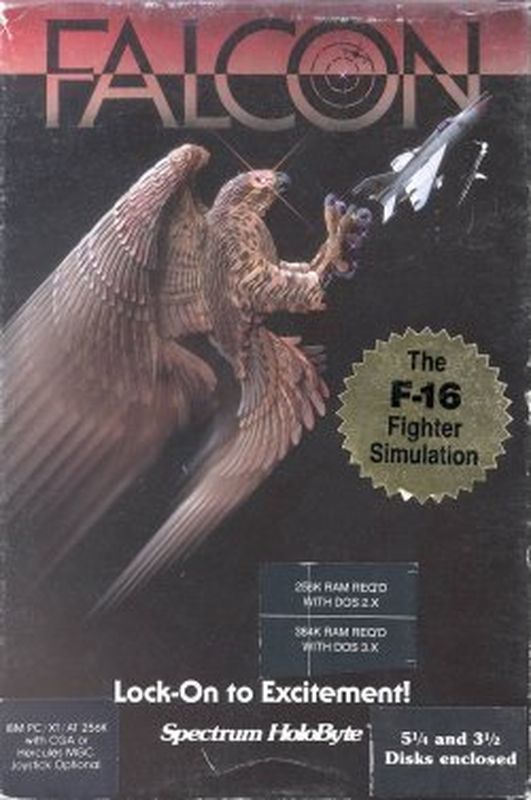
An icon of Flight Sim history, the original Falcon from 1988.
The box artwork was for Falcon quite ' ambitious '.
Who would have guessed that 10 years later sims would indeed look as good as the packaging?
Not I!
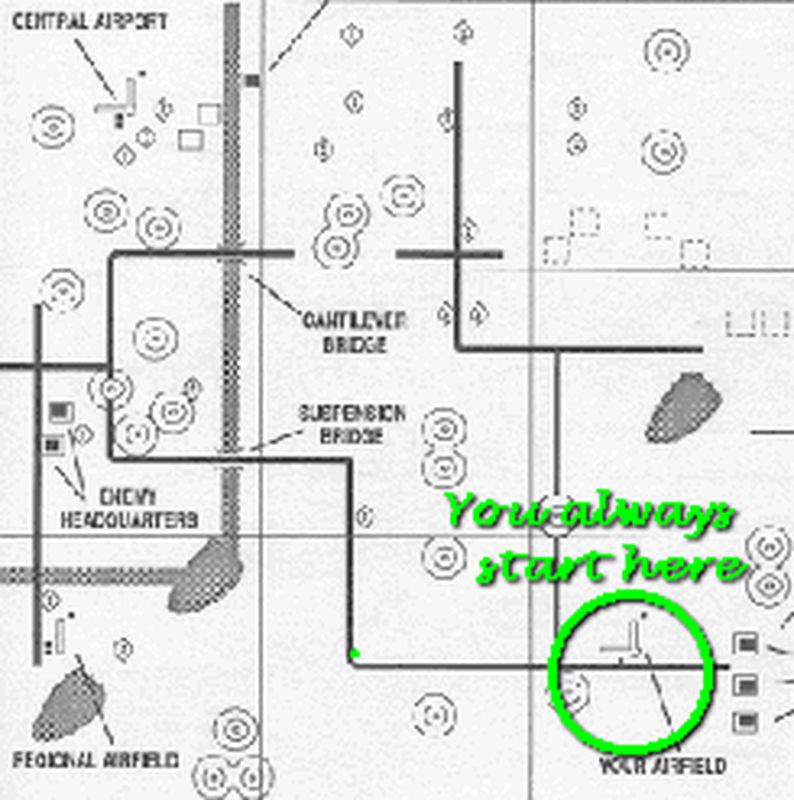
This was all there was to the original Falcon world. You could fly across it in a few minutes. And that was sufficient for hundreds of hours of entertainment!
1992 - A Harried flight
It was a dark starry night near the Pacific coast of Sydney, Australia.
The two men made their way up a winding path, dry leaves crackling underfoot.
Nestled on the cliff face they reached their destination and made their way cautiously down a broken stairway hewn from the living rock.
Arriving at a door they entered without knocking. The leader, shorter and with thinning hair, strode confidently forward. His companion, tall and dark - a Morrocan by birth, followed more hesitantly, his eyes still adjusting to the pitch blackness of the concrete bunker. Ahead, up the hallway, he saw a red glow emanating from a side room.
They padded past the first room. The Morrocan glanced in and saw what looked like a military briefing room, with aircraft models, charts, maps and what looked to be a scale models of an airbase. He had seen MiG's in Africa, he recognised them.
The next room seemed to be their destination.
As they approached it a whistling sound grew louder, then it resolved into the sound of a jet engine... and a voice.
They entered the room.
The walls were rough, unfinished stone and a they stood on a bare wooden floor. In the centre, a lone figure sat in what looked like a aircraft, or part of an aircraft.
An aircraft without wings or wheels of course, but recognisable as an aircraft.
The lone occupant was dressed in a flight suit, helmet and gloves. His hands were occupied moving between a joystick and a confusing array of buttons and switches dotted around the interior.
There was a map to one side. The visitor picked it up... some kind of military map obviously. Ahh, it was a map of East Timor.
The two visitors seated themselves behind the cockpit and watched the drama unfold on a small monitor where the front canopy would be on an aircraft.
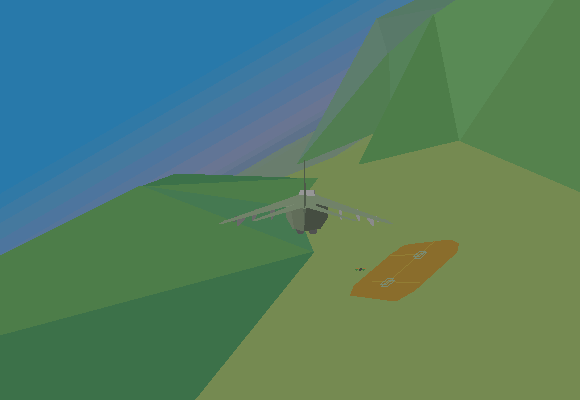
The mountains in SVGA Harrier were now joined to form ranges and valleys. Ground detail was sparse but adequate. And it ran at an amazing 600 x 400 pixels, with the addition of an SVGA graphics card.
There was a whooshing sound and a missile streaked into the distance. The plane was obviously flying low and the visitors flinched as the screen filled with a wooden hut and palm trees.
The leader admonished the pilot "Hey, you're flying pretty low!!"
The pilot's voice had gone up a few tones in pitch.
Everybody in the room had ducked for cover.
The Moroccan got up off the floor. This was absorbing!
Two sidewinder missiles streaked away from the cockpit and down below, over the village, their was a flash and a streak of oily smoke, followed by another flash and a bang as the bandit came down to earth.
"That's enough, heading home" said the pilot as he flew past the smoking wreckage and down a road to the coast, past columns of arour heading North. Everybody jumped a few inches at a loud BANG!
"Don't worry" the pilot said "that's just the ground pounders slugging it out. Never quite get used to it though. Anyway, time to concentrate... now comes the really hard part!"
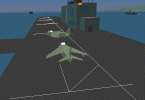
Landing on the Tarawa in SVGA Harrier was no easy task.
The next five minutes were silent except for the sound of the Harrier engines spooling up and down and the gear lowering as the plane finally set down on the Tarawa class amphibious transport.
"Hey, good flying!" the Morrocan said.
Yeah well, thanks. I've been putting the hours in so it should be. It all comes down to practice. Anyone for coffee?
Next day the Moroccan asked his friend "So, exactly which air force does that pilot fly in? ?"
It took a minute for the penny to drop, then there was laughter.
Hey, what are you laughing at man... it was a serious question!
I had no idea... we weren't... he wasn't... he isn't... it's a game! It was a game. He was playing a game.... a computer simulation!!
True story.
The year was 1992 and the sim was SVGA Harrier Assault, developed by Simis and published by Domark. The cockpit was my own. I hadn't set out to mislead my visitor. I was just doing what I did most nights in the concrete bunker, climb into my cockpit in my concrete bunker and fly!
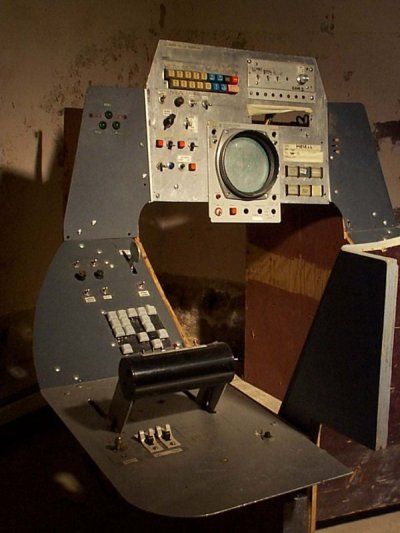
My homebuilt cockpit.
Besides being an incredibly addictive sim with a dynamic environment to fly in, SVGA Harrier Assault was one of the very first to take advantage of a leap in graphics technology: SVGA graphcs.
Super VGA upped the resolution from 320 x 200 pixels to a whopping 640 x 400.
I say whopping because the doubling of each axis of the display meant an increase in the pixels displayed from 64,000 to 307,200. Basically the image looked 5 times better, crystal clear and suddenly rivallng the top of the line military simulators.
This was incredible, this was a real breakthrough. This required a new graphics card to even run! In my case a 1 meg S3 card.
We were still flying between pyramidal mountains, but they were now rendered in gorgeous pastel shades.
1996 - Power lines at last!
Using the clunky DOS based mission editor I had managed to set up a training mission near Vladivostock where I was going to drop dumb bombs from an F/A-18 Hornet on an armoured column. Good clean fun.
The really exciting part, or one of the exciting parts, was that I could plan the route on a genuine Operational Navigation Chart (ONC) and be confident that the sim would reproduce the landmarks, elevations, built up areas and, yes, even the power lines!
I had originally bought the ONC to use in US Navy Fighters but it turned out the terrain in that sim bore only the vaguest resemblance to the real area. This was different.
Mission Studios had taken great pains to simulate the real world with over 14,400 elevation points in this area alone.
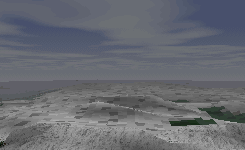
Ground detail was amazing in Jetfighter III.
Not only did the world look great at low level but the sense of speed was astounding.
Taking off in the F/A-18 and getting up to 300 knots at 500 feet felt... dangerous!
Whooooah!
This was good, fluid and convincing.
I pushed it a little lower and glanced left to see my wingman keepimg perfect formation as computer wingmen do.
I had set up enemy armour on an island South East of Vladivostock called Ostrov Askol'd.
The flight plan was simple. Fly directly South down the Peninsula and across a small strait at 200 feet, simulating a 'below radar' approach.
Then pop up at the island and drop iron the targets which were neslted on the Southern slope of Ostrov Askol'd.
Piece of cake!
I'd done similar runs hundreds of times in other sims.
Simple, a walk in the park.
Easing down to 200 feet I hugged the coastline and prepped the bombs.
That only took one button press.
Another thng I liked about his sim - the emphasis was on flying rather than switchology.
Feet wet and - yes there was the island, 5 miles out and dead centre. I pushed the Hornet into burner and the airspeed leapt up. Here's the island, up, up the hill and .... what.... !!
Holy moley! That was quick, too darn quick.
This sim really moved.
300 knots felt... fast.
Flying over a hill then trying to sight a target was .. impossible! I'd have to seriously rethink my tactics.
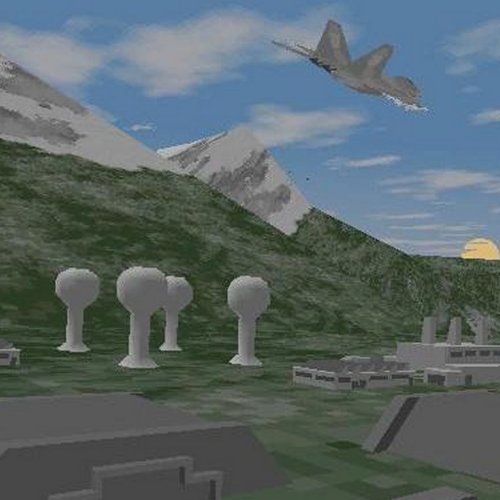
14,400 points of elevation created amazing terrain!
Jetfighter III was released just as 3DFX graphics cards came on to the market. The Jetfighter box promised "up to 16 times the speed" with the new cards and, as hard as it was for me to believe, this new technology actually delivered on the promises.
With the cards taking over the burden of drawing the pixels, creating and moving 3-D objects, while simultaneously mapping detailed textures to them, this was truly a quantum leap, a graphical afterburner.
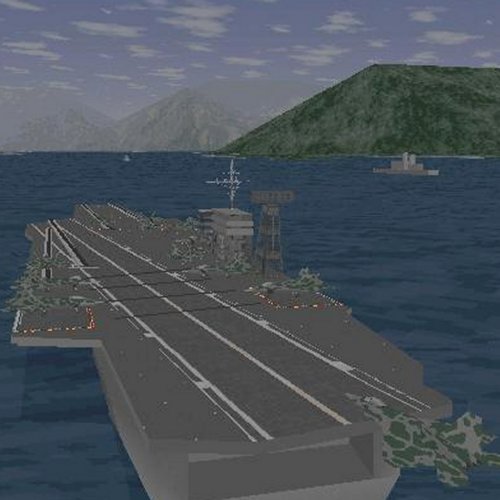
Carrier ops in Jetfighter III were intense!
Of course, really bad coding could still slow the display down but for a while your CPU speed became irrevelant and were were all enjoying smooth frame rates.
Previously I had considered anything over 5 frames per second to be a bonus, suddenly I was seeing, 15, 20, 30, 40 frames. The sky was the limit!
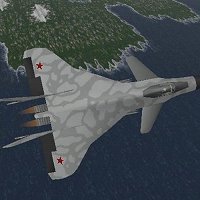
One of the great things about sims is getting the chance to fly hot aircraft that haven't been built yet (MiG-42), and then flying those aircraft at dangerously low altitudes and speeds!.
1998 - Multiplayer MiGs
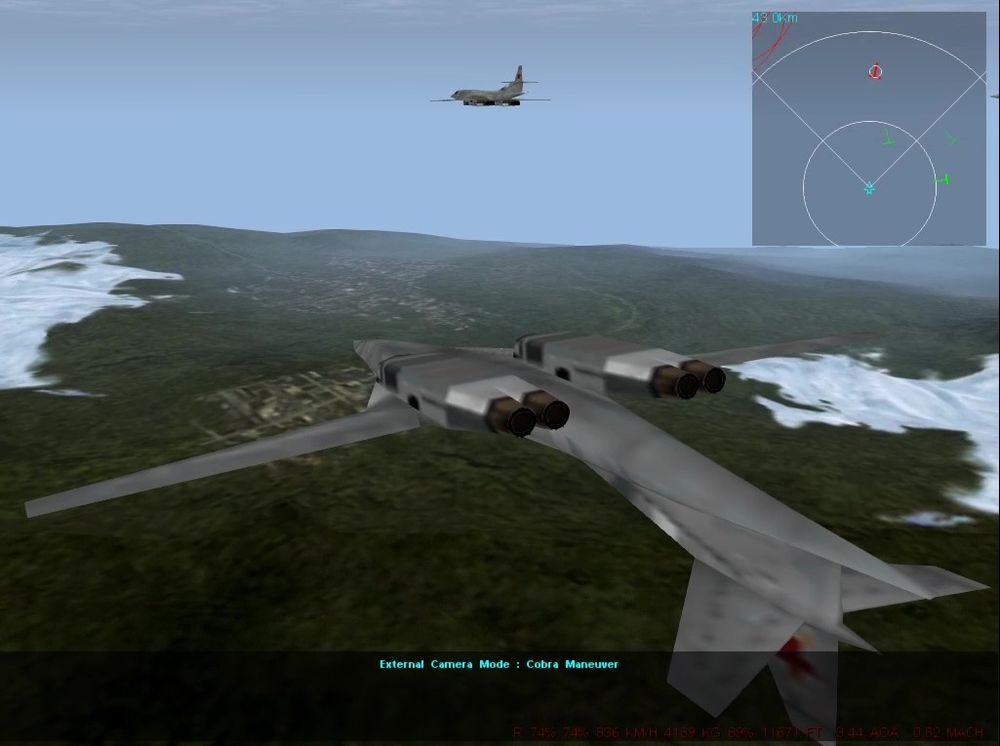
MiG-29 Fulcrum by Novalogic - 1998
I had about two seconds to break the lock of those missiles or I would be MiG-history! Time slowed as I checked my altitude. 50 feet! I had never flown this low before - and certainly not at this speed.
I rolled left into a 90 degree bank and pulled hard, sliding behind the hangars. Whamm! Bamm! A massive explosion rock the MiG as saw the screen fill with the colour of earth.
My heart popped into my mouth as I wrenched back on the stick.
No time to think!
OK, I was still flying.
The missiles must have hit the buildings. The gambit had worked.
But I couldn't do it again in a hurry. The bat-turn had bled off most of my airspeed.
Even with the the engines in full afterburner it would take maybe 5 or 10 secobnds to get back up to manoeuvering speed and in this game that was an eternity.
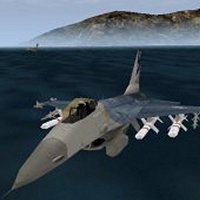
I didn't have an eternity!
The F-16's were presumably still flying. Unless I'd gotten lucky and they had hit the ground.
It happened. I always got a kick out of suckering a computer pilot into the ground.
In the early days of flight sims the computer pilots would never make mistakes like that. When coders started adding some credibile looking "fallibility factor" to their Artificial piolots it was a major step forward in enjoyment.
Unfortunately for me on this day I wasn't flying against computer pilots.
I was logged on to the internet and flying against a bunch of humans with names like "Doodz" "Grim Reaper" and so forth.
I wasn't totally alone.
There were about a dozen pilots on each side of this virtual air war, flying F-16 Falcons and MiG-29 Fulcrums. Their were also a few computer pilots manning the AWACS (Airborne Warning and Control System) aircraft and their F-15 Eagle escorts.
The AWACS were valuable assets because they provided a datalink into each cockpit with gave you a tactical overview of the whole arena. Not that there was much tactical flying going on, partly due to the incredible ferocity of the fighting. My current situation was a good example.
Survival was the name of the game.
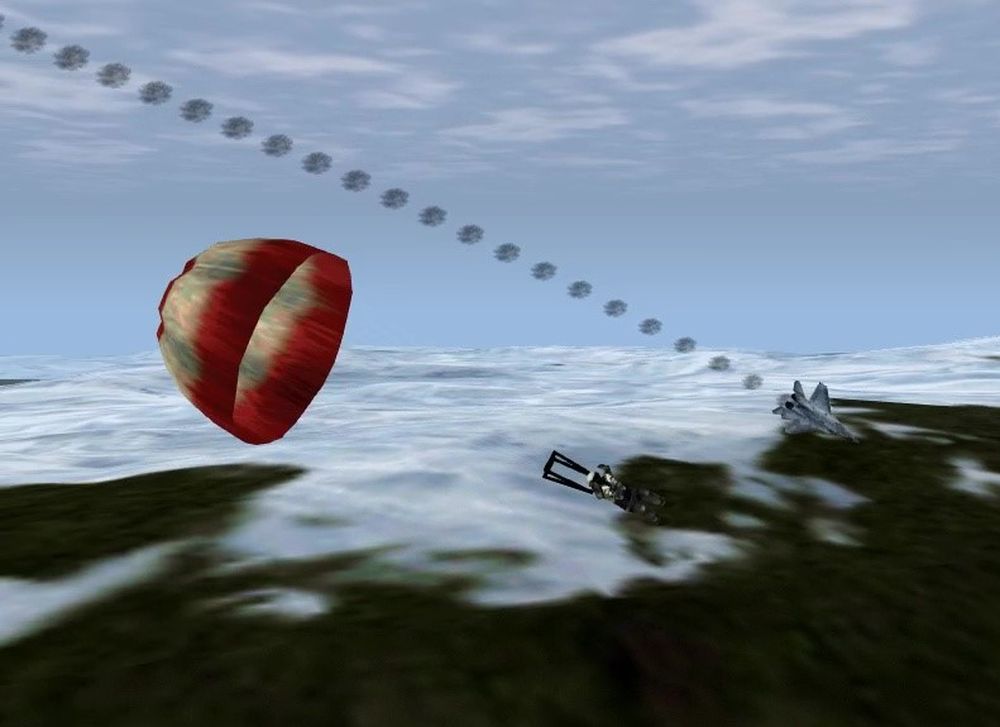
My encounters with AA missiles and SAMs often ended this way.
I had configured for air defense and taken off to patrol the airspace around one of our main bases.
While some of the team had taken off to assault the enemiy's infrastructure I was happy for the enemy to come to me.
Not that this approach could win the war, but I really really wanted to have a bash at shooting down one of the enemy's best attack pilots.
This simulation (Novalogic's F-16 Multi Role Fighter and MiG-29 Fulcrum (1998) was particularly good for practicing missile evasion. The cockpit showed a good 360 degree display of incoming missiles and you could adjust the range to suit the situation. then it was down to timing ... and skill!
Well, during the previous flight I had seen an incredible display of missile avoidance skills.
An F-16 had come screaming in over the coastline and in an awesome display of aerial ballet had dodged the missiles of two defenders and left me totally in the dust.
I turned the MiG in time to see him (her?) unload a pile of bombs smack bang on target and then turn back towards the coast and send 2 sidewinders in my direction as a parting gesture.
Result: one bombed out base and 3 very embarrased MiGs!
Anyway didn't get my rematch because two air defence F-16's turned up and, once more, I was on the defensive, flying behind those remaining hangars.
As I rolled upright the cockpit warning lights were vying for my attention. Not good. Also my sudden lurch away from terra firma had left me with the nose at about 70 degrees high with two afterburners blazing.
Oh oh.
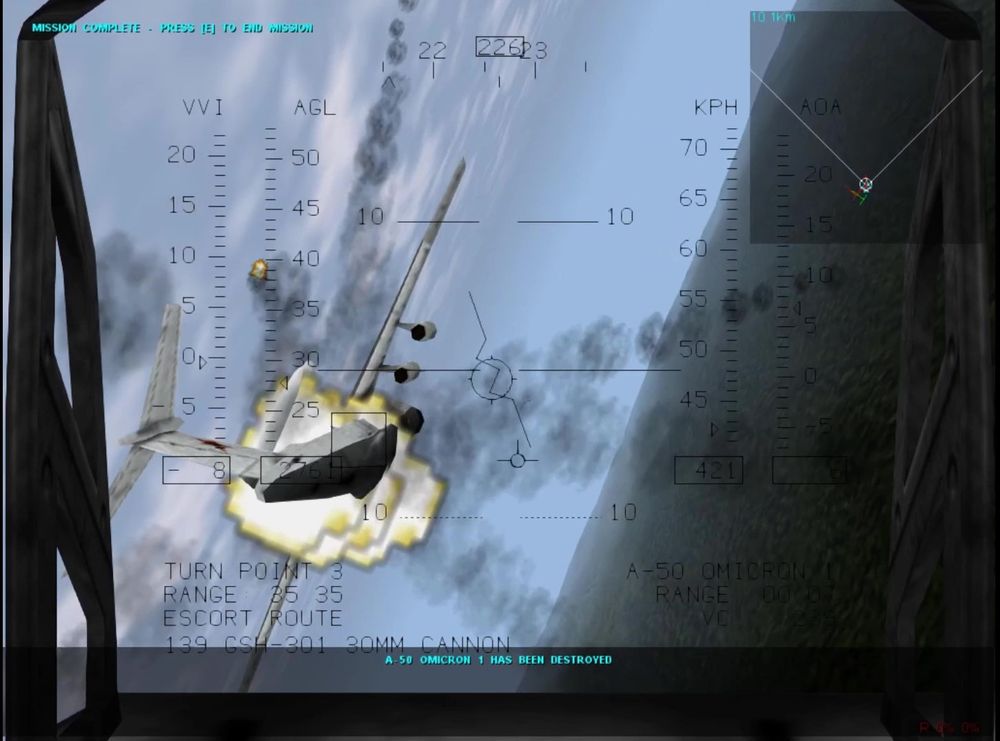
In the ensuing nano-second I contemplated my next move, which was to be:
- Roll inverted
- Pull back on the stick to get the nose down and speed up
- Cancel afterburners
- Drop more chaff and flares
- Pray
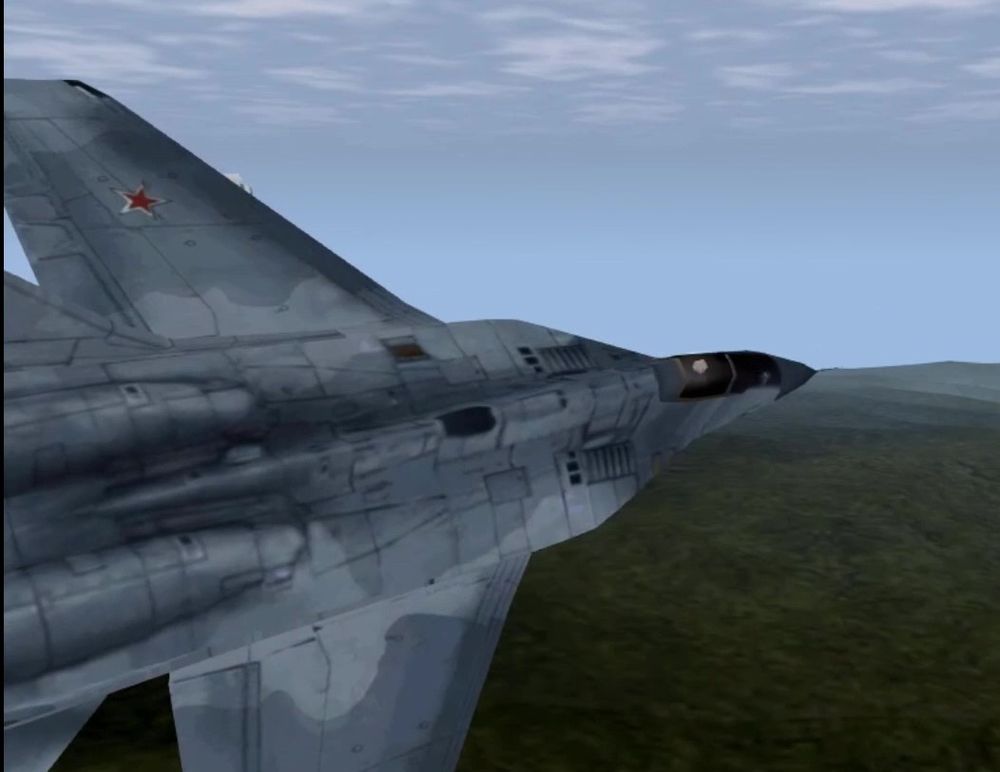
Like Icarus I flew too high and got my wings clipped.
Unfortunately for me, in that very same nano-second an AIM-9 Sidewinder found my low slow and hot MiG which exploded like a mini-Mayday celebration.
The year was 1998 and Novalogic had released 2 sims which provided the most intense and fluid simulation of jet combat seen to date.
I was amazed, not only at how fluidly the sim ran on my Pentium 266, but even more so at how well the internet multiplayer worked.
Considering that I was using a 36 K dial up modem the performance was extraordinary, with very little warping of enemy aircraft.
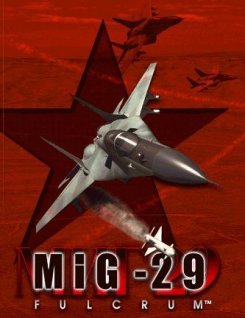
Novalogic's 1998 MiG-29 Fulcrum
Flying against other humans instead of the usual computer AI really lifted my game. I found myself flying lower, faster and generally more aggressively.
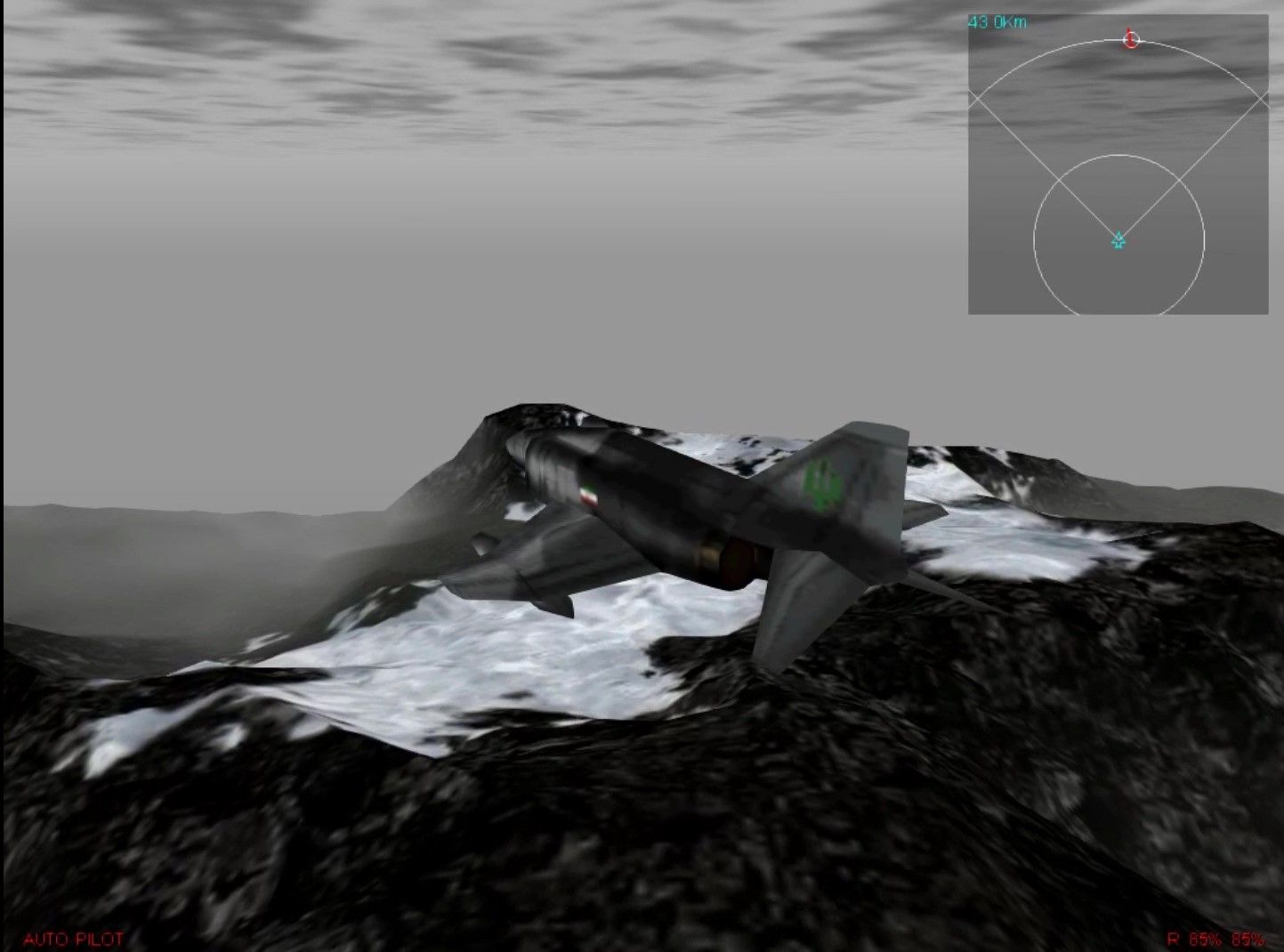
In Novalogic's MiG-29 the topography was stunning and varied with distinct types of landscape being modelled ranging from Arctic to desert.
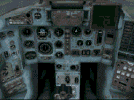
The cockpit from MiG-29 Fulcrum by Novalogic (1998).
It just gets better
So after 20 years of home flying what's next?
Well for a start:
- 64 meg Geforce graphics accelerator cards and 2,000 Khz CPU's are already standard specs in new home computer systems.
- RAM prices have dropped to the point where it's no longer a question of "how much RAM can I afford?", but rather "how much RAM do I want?".
- Matrox is releasing a card which supports 3 monitors all running a 3D accelerated display.
- Flat screen monitors are getting cheaper.
- Thrustmaster has released the Thrustmaster H.O.T.A.S. Cougar - a totally accurate metal reproduction of the F-16 Falcon control stick and throttle.
- Aimsworth in Thailand continue developing their home cockpit range.
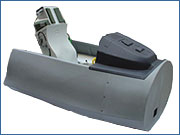
Aimsworth Viper cockpit.
The future looks rosy and those dreams of flight are coming true!
MiGMan, 2002.
